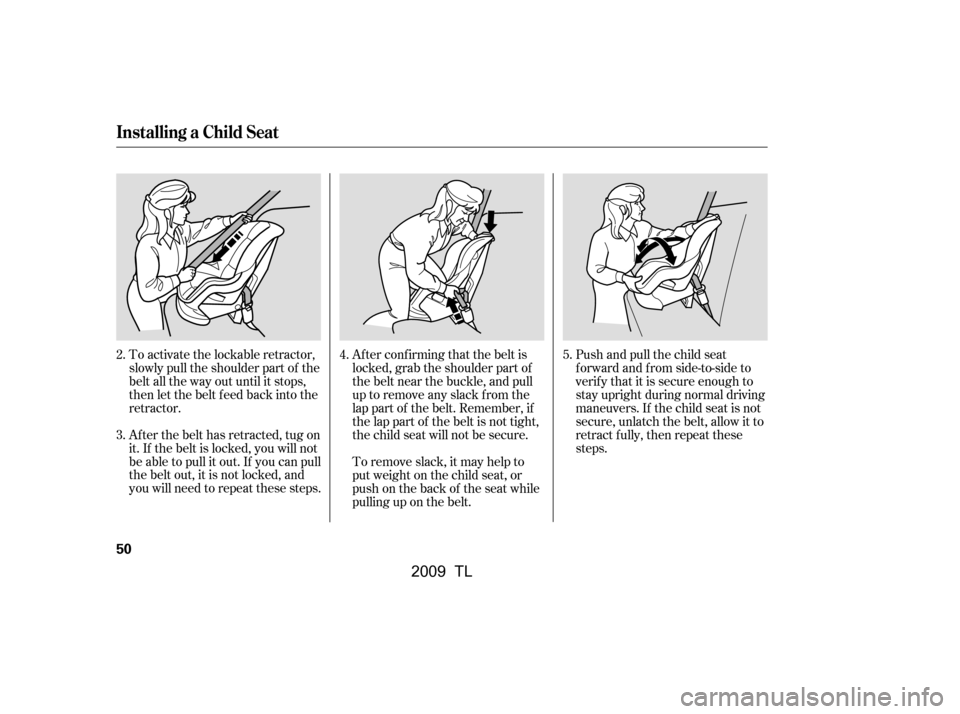Page 52 of 648
Tighten the tether strap as
instructed by the child seat maker.
Push and pull the child seat
f orward and f rom side-to-side to
verify that it is secure.When not using the LATCH system,
all child seats must be secured to the
vehicle with the lap part of a lap/
shoulder belt.
In addition, the lap/shoulder belts in
all seating positions except the
driver’s have a lockable retractor
that must be activated to secure a
child seat.
Route the tether strap over the
head restraint, then attach the
tether strap hook to the anchor,
making sure the strap is not
twisted. With the child seat in the desired
seating position, route the belt
through the child seat according
to the seat maker’s instructions,
then insert the latch plate into the
buckle.
7.
8.
9. 1.
CONT INUED
Installing a Child Seat
Installing a Child Seat with a L ap/
Shoulder Belt
Driver and Passenger Saf ety
49
TETHER STRAP HOOK
ANCHOR COVER
�\f���—�\f���—�����y�
������\f��
���y���
�)� �����\f�\f�y�\f�\f�����y
2009 TL
Page 53 of 648

Af ter the belt has retracted, tug on
it. If the belt is locked, you will not
be able to pull it out. If you can pull
thebeltout,itisnotlocked,and
you will need to repeat these steps.
To activate the lockable retractor,
slowly pull the shoulder part of the
belt all the way out until it stops,
then let the belt f eed back into the
retractor.To remove slack, it may help to
putweightonthechildseat,or
push on the back of the seat while
pulling up on the belt.
Af ter conf irming that the belt is
locked, grab the shoulder part of
the belt near the buckle, and pull
up to remove any slack from the
lap part of the belt. Remember, if
the lap part of the belt is not tight,
the child seat will not be secure.Push and pull the child seat
f orward and f rom side-to-side to
verify that it is secure enough to
stay upright during normal driving
maneuvers. If the child seat is not
secure, unlatch the belt, allow it to
retract f ully, then repeat these
steps.
2.
3.
4.
5.
Installing a Child Seat
50
�\f���—�\f���—�����y�
������\f������y���
�)� �����\f�\f�y�\f�\f�����y
2009 TL
Page 54 of 648
To deactivate the lockable retractor
and remove a child seat, unlatch the
buckle, unroute the seat belt, and let
the belt fully retract.A child seat with a tether can be
installed in any seating position in
the back seat, using one of the
anchorage points shown above.
Since a tether can provide additional
security to the lap/shoulder belt
installation, we recommend using a
tether whenever one is required or
available. Af ter properly securing the child
seat with the lap/shoulder belt
(see page ), pivot the head
restraint down (see page ) and
route the tether strap over the
head restraint.
1.
156
21
CONT INUED
Installing a Child Seat with a
Tether
Installing a Child Seat
Using an Out er A nchor
Driver and Passenger Saf ety
51
COVER
ANCHOR TETHER ANCHORAGE P
OINTSTETHER STRAP HOOK
ANCHOR COVER
�\f���—�\f���—�����y�
������\f������y���
�)� �����\f�\f�y�\f�\f�����y
2009 TL
Page 55 of 648
Lift the anchor cover, then attach
the tether strap hook to the
anchor, making sure the strap is
not twisted.
Tighten the strap according to the
seat maker’s instructions.Af ter properly securing the child
seat (see page ), push the
head restraint down, then route
the tether strap over the top of the
seat-back.
Followsteps2and3inthe
previous column.
1.
2.
3. 2.
49Using t he Cent er A nchor
Installing a Child Seat
52
TETHER STRAP
HOOKCOVER
ANCHOR
�����—�����—�����y�
�������������y���
�)� ���������y���������y
2009 TL
Page 59 of 648

If you decide that a child can saf ely
ride up f ront, be sure to:Caref ully read the owner’s manual,
and make sure you understand all
seat belt instructions and all saf ety
inf ormation.
Move the vehicle seat to the rear-
most position.
Have the child sit up straight, back
against the seat, and feet on or
near the f loor.
Check that the child’s seat belt is
properly and securely positioned.
Supervise the child. Even mature
children sometimes need to be
reminded to f asten the seat belts
or sit properly. This could result
in serious neck injuries during a
crash.
This could
cause very serious injuries during
a crash. It also increases the
chance that the child will slide
under the belt in a crash and be
injured.
If they do, they
could be very seriously injured in a
crash. Devices intended to
improve a child’s comf ort or
reposition the shoulder part of a
seat belt can make the belt less
ef f ective and increase the chance
of serious injury in a crash.
Additional Saf ety Precautions
Do not let a child wear a seat belt
across t he neck.
Do not let a child put the shoulderpart of a seat belt behind t he backor under t he arm.
T wo children should never use thesame seat belt . Do not put any accessories on a
seat belt.
Protecting L arger Children
56
�\f���—�\f���—�����y�
������
��
�
�y���
�)� �����\f�\f�y�\f�\f���
�y
2009 TL
Page 66 of 648

�Î�Î
�Î
The U.S. instrument panel is shown. Dif f erences f or the Canadian models are noted in the text.
Instrument Panel
Inst rument s and Cont rols
63
CRUISE MAIN INDICATOR CRUISE CONTROL INDICATORPARKING BRAKE AND
BRAKE SYSTEM
INDICATOR
HIGH BEAM INDICATOR
LOW FUEL INDICATOR IMMOBILIZER SYSTEM
INDICATOR
SIDE AIRBAG OFF INDICATOR
MALFUNCTION INDICATOR LAMP
SH-AWD INDICATOR LIGHTS ON INDICATOR LOW TIRE PRESSURE/TPMS INDICATOR
If equipped
: SECURITY SYSTEM INDICATOR
SUPPLEMENTAL RESTRAINT SYSTEM INDICATOR
ANTI-LOCK BRAKE SYSTEM (ABS) INDICATOR
KEYLESS ACCESS SYSTEM INDICATOR ELECTRIC POWER STEERING
(EPS) INDICATOR
VSA ACTIVATION
INDICATOR
FOG LIGHT INDICATOR VEHICLE STABILITY ASSIST (VSA)
SYSTEM INDICATOR SEAT BELT REMINDER
INDICATOR CHARGING SYSTEM INDICATOR
LOW OIL PRESSURE INDICATOR DOOR/TRUNK OPEN INDICATOR
(P.65,595)
(P.64,595)
(P.64,596)(P.71)
(P.64)(P.68) (P.73)
(P.68)
(P.71) (P.72)
(P.74)(P.69) (P.72)
(P.72)
(P.67) (P.73)
(P.65,597)
(P.65)
(P.70)
(P.71)
(P.67) (P.66)
(P.73)
SYSTEM MESSAGE INDICATOR (P.72)
MULTI-INFORMATION DISPLAY (P.77)
�����—�����—�����y�
���������
���y���
�)� ���������y���������y
2009 TL
Page 76 of 648

�Î
�Î
This indicator is in the f uel gauge. It
comesonasareminderthatyou
must ref uel soon. You will also see a
‘‘LOW FUEL’’ message on the multi-
inf ormation display.
When the indicator comes on, there
are about 2.5 U.S. gal (9.6
)on
SH-AWD models, and 2.8 U.S. gal
(10.5
)on2WDmodelsof fuel
remaining in the tank. When the needle reaches E, there is
a very small amount of f uel in the
tank.
This indicator comes on when the
security system is set. For more
inf ormation, see page .
This indicator normally comes on f or
a f ew seconds when you turn the
ignition switch to the ON (II)
position. If this indicator comes on at
any other time, there is a problem in
the SH-AWD system. You will also
see a ‘‘CHECK SH-AWD SYSTEM’’
message on the multi-information
display (see page ). Take your
vehicle to a dealer to have it checked.
For more inf ormation, see page .
Models equipped with the
keyless access system have an
engine start/stop button instead
of an ignition switch. ON Mode
is the equivalent of ON (II). For
more inf ormation, see pagesand . 517
380 518
:
180
178
CONT INUED
On SH-AWD models
Low Fuel Indicator
Security System Indicator Super Handling-All
Wheel Drive (SH-AWD)
Indicator
Instrument Panel Indicators
Inst rument s and Cont rols
73
LOW FUEL INDICATOR
SECURITY SYSTEM INDICATOR
U.S. model is shown.
�\f���—�
���—�����y�
�������������y���
�)� �����\f�\f�y�\f�\f�����y
2009 TL
Page 82 of 648

�Î
CONT INUED
In the multi-information display, the
system message is also displayed
(see page ) and you can
customize your vehicle control
settings (see page ).In the normal display mode, the
upper segment displays trip
computer inf ormation, such as f uel
economy or average speed. The
lower segment displays the
odometer/trip meter (A/B), outside
temperature, and engine oil lif e and
maintenance item code(s).
The multi-inf ormation display
consists of an upper segment and a
lower segment. You will see some keyless access
system messages until you select the
ON mode by operating the engine
start/stop button. These messages
canbecustomized(seepage ).
Models equipped with the
keyless access system have an
engine start/stop button instead
of an ignition switch. ON Mode
is the equivalent of ON (II). For
more inf ormation, see pages
and . 87
91
105
:
180
178
On models with keyless access system
Multi-Inf ormation Display
Inst rument s and Cont rols
79
LOWER
SEGMENT
UPPER
SEGMENT
U.S. model is shown.
�����—�
���—�����y�
�������������y���
�)� ���������y���������y
2009 TL